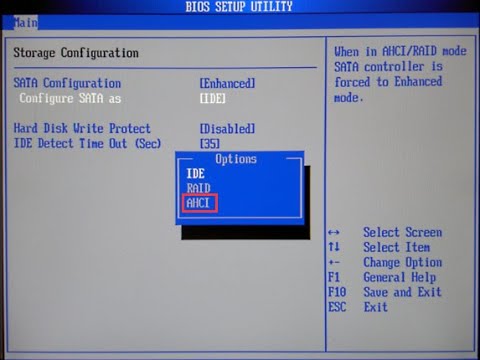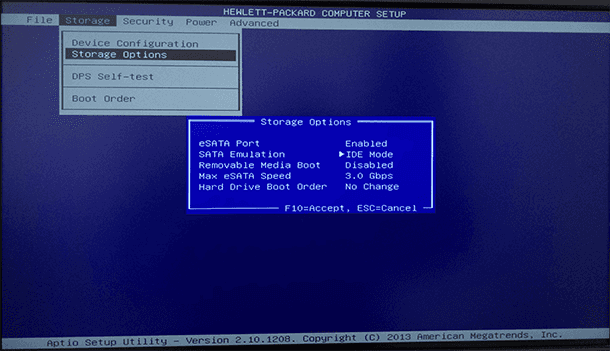Table of Contents
PC running slow?
Today’s user guide is written to help you when you receive a bios SATA IDE AHCI RAID Configuration error message. If you are using a SATA SSD, AHCI is probably better than RAID. If you are using multiple hard drives, RAID is a better choice than AHCI. If you want to use additional SSDs and hard drives from RAID mode, it is recommended that you continue to use RAID mode itself.
Always turn on the system.Press the F2 key at the Sun logo screen to open the BIOS setup menu.In the BIOS utility dialog, specifically Advanced -> IDE Setup.From the IDE configuration menu, select “Configure SATA as” and press Enter accordingly.
IDE, AHCI, and RAID are modes that work under SATA conditions. Each of them has its own relative strength in addition to its own weakness. And
IDE AHCI are PCI (Peripheral Component Interconnect) inventions that move data between system storage and SATA controllers. Both add more advanced features to the garage. AHCI is newer than IDE and provides advanced storage options. However, these are two older technologies that are no longer used in storage arrays, especially with the rise of SSDs.
RAID is an application or programSoftware that provides redundancy for a range of device environments and speeds up drives. Because AHCI, IDE, and RAID support SATA controllers, many RAID products support AHCI when created to provide enhanced storage capabilities in single drive applications.
What Is AHCI?
Should SATA mode be AHCI or IDE?
In general, IDE mode provides more compatibility with older hardware. However, in IDE mode, the hard drive can run onmuch slower. If you want to install more than any hard drive and enjoy the latest SATA features, AHCI mode is your best bet.
PC running slow?
ASR Pro is the ultimate solution for your PC repair needs! Not only does it swiftly and safely diagnose and repair various Windows issues, but it also increases system performance, optimizes memory, improves security and fine tunes your PC for maximum reliability. So why wait? Get started today!

Advanced Host Interface Controller (AHCI) is a homogeneous Intel computer limited to Intel chipsets. AHCI has been around since 2004 when this element replaced the old IDE/Parallel ATA interface used in newer devices.
AHCI is not the same as SATA, but acts as a bus between the entire host and the AHCI or SATA controllers on the motherboard. The protocol enhances storage functionality on the SATA controller through native support for command queuing (NCQ)and internal exchange.
However, it can only handle a limited IQ of requests, as it can certainly hold 32 I/O requests per line. Built-in command queuing (NCQ) improves the transfer speed of AHCI files on hard drives by limiting head movement and read/write operations, thereby speeding up time savings. While this works with SSDs, out is not very useful since SSDs don’t actually have moving parts.
AHCI Windows supports Linux operating systems, but UNIX. Please note that SATA SSDs do not use AHCI, which is their software protocol between the CPU and their SATA controller.
Should SATA mode be AHCI or IDE?
Should the SATA mode be AHCI and/or maybe IDE? Overall, IDE mode offers excellent compatibility with older hardware. But all hard drives can run slower in IDE mode. If you want to connect multiple hard drives and take advantage of the advanced features of SATA, AHCI mode is the best choice.
The much newer NVMe standard is indeed replacing AHCI-compliant SSDs in resource intensive environments where mining is not possible. NVMe (Non-Volatile Memory Express) interface between NAND flash and SSDs with PCIe cards. AHCI has a maximum queue depth of 34. NVMe greatly reduces latency and maintains a queue depth of 65,000.
What Is Driveide?
Which is better IDE AHCI or RAID?
AHCI is newer with IDE and provides enhanced storage functionality. However, both are older products that are not widely used in storage arrays, especially given my growth in the field of solid state drives. RAID is garden or software that provides redundancy in multi-device environments and speeds up hard drives.
Inline elementElectronics (IDE) preceded AHCI. It identifies the computer whose interface connects hard drive storage to the motherboard’s storage bus. In 1986, Western Digital released the IDE specification with Compaq and Control Data Corp.
At one time, IDE-based ATA drives were much faster than standard SCSI drives, and the market embraced newer IDE platforms. Also known as parallel ATA, PATA, or IDE connections, the simultaneous transfer of 16 bits over two device connections per channel.
What is AHCI and IDE in BIOS?
AHCI is essentially a technical standard defined by Intel that defines the behavior of Serial ATA (SATA) host controllers in a different, non-implementation-related manner. IDE is an urban standard for connecting storage systems such as hard drives, weak hard drives, and optical drives in computers.
Using an IDE in flash is possible in a limited case: compact flash in an IDE process. This is an extremely compact ATA user interface and is sometimes found in older computing devices. CFast is a development variant of CF, but it uses SATA, not PATA.

Today, IDE/PATA is largely obsolete. While IDE drives or those used in older production systems can still be found on the market, Western Digital and Seagate stopped manufacturing and shipping these drives in 2013.
What RAID?
RAID or “Redundant Array of Other Disks” is another mature technology.Yes, but it is likely to be widely used in storage environments.

RAID provides high availability and data protection across all nodes, some of which allow HDDs and SSDs to continue working after a device is lost. RAID is available for SSD arrays. But since it does not increase the speed of the SSD, 100 flash arrays will most likely use a single RAID, which provides redundancy and speeds up normal day-to-day SSD operations.
Storage administrators may occasionally install RAID in the form of a hardware, microchip, or software controller card with or without a completely new hardware component. The RAID card controller is, of course, a removable expansion card that plugs into a PCIe or PCI-X motherboard slot. They are host independent, so most RAID operations are offloaded from the CPU to the dedicated card. RAID-on-Chip resides on the motherboard and integrates the host system, hard drive I/O interfaces, processor, RAID, and storage controller.
The most common types or levels of RAID are 1, 8, 5, 6, and 10. There are sometimes SSD RAID options on the market.
Which is better IDE AHCI or RAID?
AHCI is newer than IDE and provides extended service area functionality. However, both technologies are older and rarely used in space arrays, especially with the growth in the number of solid stateth drives. RAID is hardware or software that provides redundancy in multi-device environments and increases the number of hard drives.
SSDs can use traditional RAID levels. Although RAID can improve the performance of SSDs,Hey, the original high speeds don’t benefit from the RAID speed boost. SSD vendors eventually focused on adding their own RAID capabilities to over 100 flash arrays.
For example, Dell XtremIO Data Protection speeds up and protects Dell 100 all-flash arrays, even though Pure Storage adds its AFAs to raid-3d.
Technology Comparison
There are no competitors on the market between Et ahci IDE. They serve parallel purposes as both allow storage media to interact with the computer’s human body through a SATA storage controller. But AHCI is significantly faster than IDE, which is still an older technology niche for legacy internet systems.
AHCI does not compete with RAID, typically providing redundancy and data protection over SATA using AHCI connections for drives. Actually, Intel RAID motherboards support AHCI because it’s quite possible.
The value of RAID is very different from AHCI. RAID improves redundancy and data protection associated with HDD/SSD disk clusters. This allows administrators to use multiple devices.storage as separate volumes, provide redundancy in case of device loss, and improve performance by consolidating data warehouse tasks across multiple storage devices.
Improve the speed of your computer today by downloading this software - it will fix your PC problems.What is AHCI and IDE in BIOS?
AHCI is a technical standard defined by Intel that defines how Serial ATA (SATA) host controllers work in ways that are not implementation related. IDE is an interface standard for connecting storage devices such as problematic hard drives, floppy drives, and hard drive locks in computers.
What is SATA mode IDE and AHCI?
IDE mode is the simplest state. IDE mode configures the hard drive to act as an IDE or Parallel ATA (PATA) hard drive. Advanced Host Controller Interface (AHCI) mode allows advanced SATA drive features such as hot-swapping and native command queuing (NCQ).
Hur Man åtgärdar SATA BIOS Setup IDE Ahci Raid Error
Come Risolvere L’errore Raid Ahci Dell’IDE Di Configurazione Del BIOS SATA
Jak – Naprawić Błąd Konfiguracji IDE Ahci Raid SATA BIOS
Sata BIOS Setup IDE Ahci Raid-fout Herstellen
Как убедиться, что вы исправили ошибку SATA BIOS Setup IDE Ahci Raid
Cómo Reparar El Error De Incursión IDE Ahci De La Configuración Del BIOS SATA
Comment Réparer L’erreur De Raid Ahci De L’IDE De Configuration Du BIOS SATA
SATA BIOS 설정 IDE Ahci Raid 오류를 수정하는 방법
Como Corrigir O Erro De Raid Ahci Do IDE De Configuração Do BIOS SATA
So Beheben Sie Endlich Den IDE-Ahci-Raid-Fehler Im SATA-BIOS-Setup